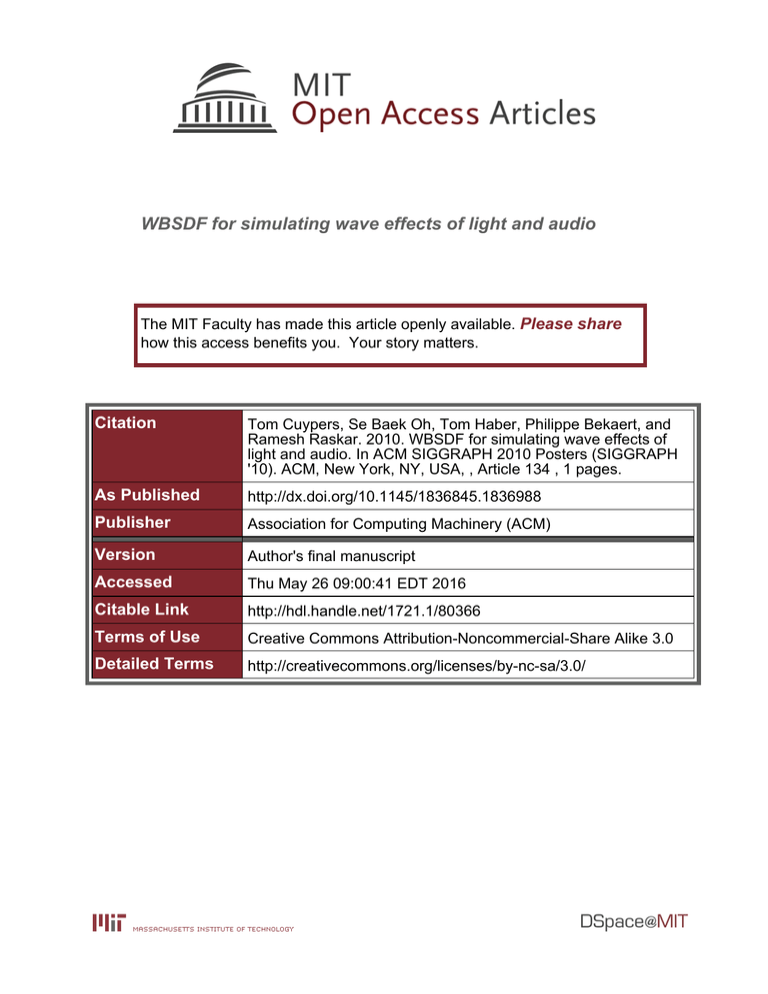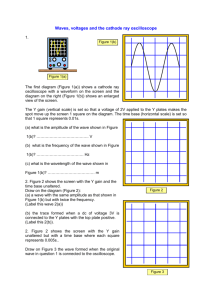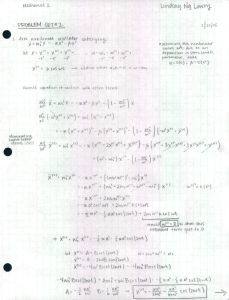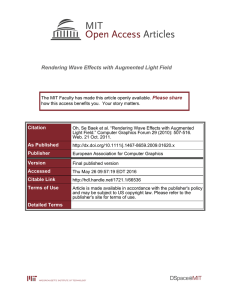WBSDF for simulating wave effects of light and audio Please share
advertisement

WBSDF for simulating wave effects of light and audio The MIT Faculty has made this article openly available. Please share how this access benefits you. Your story matters. Citation Tom Cuypers, Se Baek Oh, Tom Haber, Philippe Bekaert, and Ramesh Raskar. 2010. WBSDF for simulating wave effects of light and audio. In ACM SIGGRAPH 2010 Posters (SIGGRAPH '10). ACM, New York, NY, USA, , Article 134 , 1 pages. As Published http://dx.doi.org/10.1145/1836845.1836988 Publisher Association for Computing Machinery (ACM) Version Author's final manuscript Accessed Thu May 26 09:00:41 EDT 2016 Citable Link http://hdl.handle.net/1721.1/80366 Terms of Use Creative Commons Attribution-Noncommercial-Share Alike 3.0 Detailed Terms http://creativecommons.org/licenses/by-nc-sa/3.0/ WBSDF for Simulating Wave Effects of Light and Audio Tom Cuypers1 1 Se Baek Oh2 Hasselt University - tUL - IBBT Expertise Centre for Digital Media Tom Haber1 2 Philippe Bekaert1 Mechanical Engineering MIT 3 Ramesh Raskar3 Camera Culture Group MIT MediaLab This transformation function for incoming and outgoing wavefronts in this space is 4D under the assumption of a thin element, which is calculated using the well–studied WDF: Z 0 x0 ∗ x0 Wt (x, u) = t x + t x− e−i2πx u dx0 , (1) 2 2 Figure 1: We propose the Wave BSDF (WBSDF) for rendering wave phenomena in light and audio. The WBSDF behaves as a local scattering function, while simulating interference globally, and allows for easy integration into traditional ray–based methods. 1 Introduction Diffraction is a common phenomenon in nature when dealing with small scale occluders. It can be observed on biological surfaces, such as feathers and butterfly wings, and man–made objects like rainbow holograms. In acoustics, the effect of diffraction is even more significant due to the much longer wavelength of sound waves. In order to simulate effects such as interference and diffraction within a ray–based framework, the phase of light or sound waves needs to be integrated. We introduce a novel method for creating Bidirectional Scattering Distribution Functions (BSDFs) that efficiently simulate diffraction and interference in light and sound in ray–based frameworks. The reflected or scattered radiance of a ray indirectly and independently encodes the mutual phase information among the rays, conveniently allowing for interference after multiple bounces. Previous work has described how to add local diffraction and interference effects to the Bidirectional Reflection Distribution Function (BRDF) [Stam 1999]. However, a traveling ray does not carry phase information and therefore is unable to interfere in a later stage. Our BSDFs, derived from the Wigner Distribution Function (WDF) in wave optics, abstract away the complexity of phase calculations. Traditional ray–based renderers, without modifications, can directly use these WBSDFs. 2 Wave Based BSDF In optics, parallel waves are often described as a function of spatial frequency u and position x. Any wavefront can be subdivided in a series of parallel waves, each with its own spatial frequency. In the paraxial zone, where the observation is near the optical axis, this spatial frequency is related to the wavelength and the direction of rays, which is normal to the wavefront, as u = (sin θ)/λ. When a wave is transmitted or reflected it is transformed due to its microstructure. As pointed out in previous research [Zhang and Levoy 2009; Oh et al. 2010], the light field L in position–angle space exhibits similar properties as the Wigner Distribution Function (WDF) representation R in spatial–frequency space: L(x, θ) ∼ R (x, (sinθ)/λ). where t(x) is a complex function describing amplitude and phase variation of the wave due to the surface structure and ∗ denotes complex conjugate. Note that Wt (x, u) may contain positive as well as negative real–valued coefficients. However, after integration of all incoming rays, for example in a camera aperture, its value – intensity – always becomes non–negative. We can therefore write the light and audio transport for wave rendering for thin microstructures as: Z Ro (x, uo ) = Re (x, uo ) + Wt (x, −uo − ui )Ri (x, ui )dui . (2) Where Ro and Ri are the incoming and outgoing light or sound and the BRDF is calculated using the WDF. Re is the light or sound emitted by the object. This simple method precomputes the BSDF for the entire microstructure, which can be used independently for each patch. Hence, the WBSDF allows us to use traditional ray– based rendering pipelines to synthesize wave effects of light and sound. We can derive the light or audio transport for coherent as well as incoherent sources. Together with optimizations, such as importance sampling and lookup tables, we can efficiently simulate wave phenomena in the near and far field. 3 Results We implemented this as a new material plugin for PBRT to generate diffractive materials. In order to make the renderer work with this new material, we only disable the security check for non–negative radiance. No further changes were made to the framework. Using photon mapping as a global illumination technique, the rendering took 1700s to render on a 3GHz Core. Additionally, we used a ray tracer for audio rendering without phase tracking. We simulated an interesting effect where a closing sliding door can increase the audio intensity. These results are shown in figure 1. References O H , S. B., K ASHYAP, S., G ARG , R., C HANDRAN , S., AND R ASKAR , R. 2010. Rendering wave effects with augmented light fields. EuroGraphics. S TAM , J. 1999. Diffraction shaders. In Proceedings of SIGGRAPH 1999, ACM Press / ACM SIGGRAPH, Computer Graphics Proceedings, Annual Conference Series. Z HANG , Z., AND L EVOY, M. 2009. Wigner distributions and how they relate to the light field. In IEEE Internatinoal Conference on Computational Photography.








